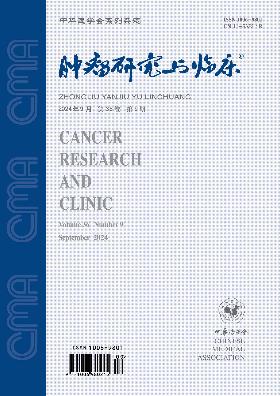Clinical analysis of BRCA mutations in patients with recurrent serous ovarian cancer
Q4 Medicine
引用次数: 0
Abstract
Objective To investigate the BRCA1 and BRCA2 gene mutations in patients with recurrent serous ovarian cancer and their clinical significances. Methods A total of 57 patients with recurrent serous ovarian cancer in the First Affiliated Hospital of Nanchang University from January 2016 to January 2018 were collected. High-throughput second-generation sequencing technology was used to detect BRCA1 and BRCA2 mutations in patients' blood. Statistical analysis was performed on the relationship between BRCA mutations and clinicopathological factors and prognosis. Results Of the 57 patients with recurrent serous ovarian cancer, 16 patients (28.07%) had BRCA mutations, among which 3 patients (5.26%) had nonsense mutations, 7 patients (12.28%) had frameshift mutations, and 7 patients (12.28%) had missense mutations. There was no significant difference in BRCA mutation rate among patients with different American Obstetrics and Gynecology Union (FIGO) stage, lymphatic metastasis, tissue differentiation and age stratification (all P > 0.05). Patients with family history of ovarian cancer or breast cancer had a higher BRCA mutation rate than patients without family history (7/12 vs. 9/45, χ2 = 5.13, P = 0.02), and patients who were sensitive to first-line platinum treatment had a higher BRCA mutation rate than those with drug resistant (16/45 vs. 0/12, P = 0.04). Patients with BRCA mutation had a lower serum CA125 level than patients with BRCA wild-type [(774±548)×103 U/L vs. (1 522±1 269)×103 U/L, t = 3.106, P = 0.003], and a longer median progression-free survival (PFS) time (20.5 months vs. 12.0 months, P = 0.01). Conclusions Serous ovarian cancer patients with BRCA mutations have higher sensitivity to platinum-based chemotherapeutic drugs and better PFS. Detection of BRCA mutations helps to judge prognosis and guide medication. Key words: Ovarian neoplasms; Recurrence; Mutation; BRCA gene复发性浆液性卵巢癌症BRCA突变的临床分析
目的探讨复发性浆液性卵巢癌患者BRCA1和BRCA2基因突变及其临床意义。方法收集2016年1月至2018年1月南昌大学第一附属医院收治的复发性浆液性卵巢癌患者57例。采用高通量第二代测序技术检测患者血液中的BRCA1和BRCA2突变。统计分析BRCA突变与临床病理因素及预后的关系。结果57例复发性浆液性卵巢癌患者中,有16例(28.07%)发生BRCA突变,其中无义突变3例(5.26%),移码突变7例(12.28%),错义突变7例(12.28%)。不同FIGO分期、淋巴结转移、组织分化、年龄分层患者BRCA突变率差异无统计学意义(P < 0.05)。有卵巢癌或乳腺癌家族史的患者BRCA突变率高于无家族史的患者(7/12比9/45,χ2 = 5.13, P = 0.02),一线铂类药物治疗敏感的患者BRCA突变率高于耐药患者(16/45比0/12,P = 0.04)。BRCA突变患者血清CA125水平低于BRCA野生型患者[(774±548)×103 U/L比(1 522±1 269)×103 U/L, t = 3.106, P = 0.003],中位无进展生存期(PFS)时间更长(20.5个月比12.0个月,P = 0.01)。结论BRCA突变的浆液性卵巢癌患者对含铂类化疗药物敏感性较高,PFS较好。检测BRCA突变有助于判断预后和指导用药。关键词:卵巢肿瘤;复发;突变;BRCA基因
本文章由计算机程序翻译,如有差异,请以英文原文为准。
求助全文
约1分钟内获得全文
求助全文
来源期刊

肿瘤研究与临床
Medicine-Oncology
CiteScore
0.10
自引率
0.00%
发文量
7737
期刊介绍:
"Cancer Research and Clinic" is a series of magazines of the Chinese Medical Association under the supervision of the National Health Commission and sponsored by the Chinese Medical Association.
It mainly reflects scientific research results and academic trends in the field of malignant tumors. The main columns include monographs, guidelines and consensus, standards and norms, treatises, short treatises, survey reports, reviews, clinical pathology (case) discussions, case reports, etc. The readers are middle- and senior-level medical staff engaged in basic research and clinical work on malignant tumors.
 求助内容:
求助内容: 应助结果提醒方式:
应助结果提醒方式:


